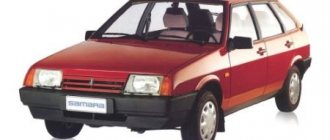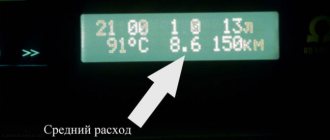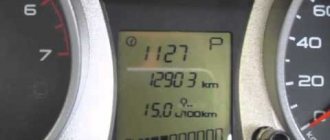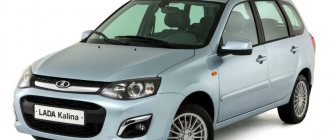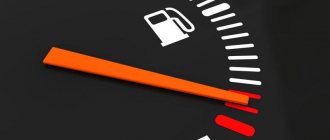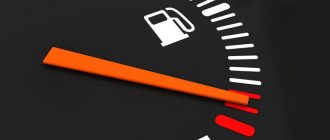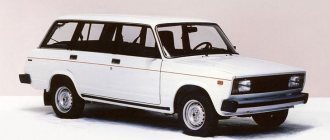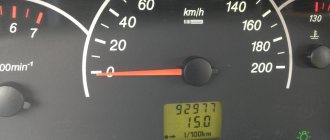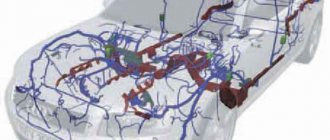The fuel consumption of the VAZ 2107 per 100 km depends on many factors. These include the following: vehicle speed, engine type and fuel supply system. What is the fuel consumption of a VAZ 2107 with a carburetor? According to documents for this model of car, the average fuel consumption on the highway is 6.8 liters, if the speed is about 90 km/h. P When driving in city mode, this figure increases significantly - up to 9.6 liters.
What you need to know to reduce fuel consumption
Checking the air damper in the carburetor
Higher fuel consumption on a VAZ 2107 with a carburetor engine occurs if the air damper is not fully open. What is its correct position? Surely, an experienced driver knows that when the engine in the car is running, the choke in the carburetor must be in a vertical position. The choke handle must be fully extended towards you. Fuel consumption at idle speed in the VAZ 2107 can be reduced by specially setting the carburetor air damper to some extent. But such manipulation is not effective enough.
| Engine | Consumption (highway) | Consumption (city) | Consumption (mixed cycle) |
| 1.3 l 4-mech (gasoline) | 7.8 l/100 km | 11.5 l/100 km | 10.5 l/100 km |
| 1.4 l 5-mech (gasoline) | — | 9 l/100 km | — |
| 1.5 l 5-mech (gasoline) | 5.2 l/100 km | 8.9 l/100 km | 7 l/100 km |
| 1.6 l 5-mech (gasoline) | — | 8.5 l/100 km | — |
| 1.3 l 5-mech (gasoline) | 9.5 l/100 km | 12.5 l/100 km | 11 l/100 km |
The reasons for the high fuel consumption on VAZ 2107, the carburetor of which is in a faulty condition, speak for themselves. Young drivers do not always take the time to thoroughly check their car, and this can lead to negative consequences. Other factors of uneconomical fuel consumption may include:
- incorrect speedometer readings;
- malfunction of the device that measures the level of gasoline in the tank;
- driver's driving style.
Other factors affecting fuel consumption
In addition to climatic conditions and the age of the car, many other factors affect fuel consumption. It is not possible to list them all in one short article, so we will focus only on the most basic ones, the influence of which the driver can reduce.
Low tire pressure
Like any other car, the VAZ 2107 has tire pressure standards depending on the load. For standard 175–70R13 tires these figures are as follows:
- if there are 3 people in the cabin, then the pressure in the front tire should be 1.7 bar, in the rear tire - 2.1 bar;
- if there are 4–5 people in the cabin and there is cargo in the trunk, then the pressure in the front tire should be at least 1.9 bar, in the rear 2.3 bar.
Any downward deviation from the above values inevitably leads to increased fuel consumption. This is due to the fact that a flat tire has a significantly larger contact patch with the road. In this case, rolling friction increases significantly and the engine is forced to burn more fuel in order to overcome this friction.
The larger the contact patch of the “Seven” tires with the road, the higher the fuel consumption
The relationship between pressure and consumption is inverse: the lower the tire pressure, the higher the fuel consumption. In practice, this means the following: if you reduce the pressure in the tires of the “seven” by a third, then fuel consumption can increase by 5–7%. It should also be noted here that driving on half-flat tires is simply dangerous: on a sharp turn the tire can fly off the rim. The wheel will disassemble, and the car will immediately lose control. This could cause a serious accident.
Driving style and its correction
Driving style is another important factor, the influence of which the driver can easily correct on his own. If the driver wants to reduce fuel consumption, the car must move as smoothly as possible. First of all, this rule concerns braking. You should brake as little as possible (but, of course, not at the expense of your own safety). To fulfill this condition, the driver must learn to clearly predict the situation on the road, and then accelerate the car to the speed that is appropriate at the moment, without exceeding it. A novice driver should learn to approach traffic lights smoothly, change lanes in advance, etc. All these skills come with time.
If you have an aggressive driving style, the VAZ 2107 will have to be refueled very often.
Of course, the driver will still have to brake. But you need to know the following: on injection cars with manual transmissions, braking with the gear engaged turns off the injection system. As a result, the car continues to move by inertia without consuming fuel. So when approaching a traffic light, it is more useful to brake with your engine.
As for acceleration, there is one common misconception: the smoother the acceleration, the lower the fuel consumption. This is wrong. With this acceleration scheme, the final (and not momentary) fuel consumption will be greater than during fast acceleration with a deeply recessed pedal. When the car accelerates smoothly, its throttle valve is closed halfway. As a result, additional fuel is spent pumping air through the throttle. And if the driver presses the pedal to the floor, the throttle valve opens almost completely, and pumping losses are reduced.
Low temperature
It was already mentioned above that low temperatures increase fuel consumption. Let's take a closer look at why this happens. When it's cold outside, all working processes in the engine deteriorate. The density of cold air increases significantly, therefore, the mass of air that the engine sucks in increases. Cold gasoline also has increased density and viscosity, and its volatility is sharply reduced. As a result of all these processes, the fuel mixture entering the engine in the cold becomes very lean. It ignites poorly, burns poorly and never burns completely. A situation arises when a cold engine, not having had time to completely burn the previous portion of fuel, already requires the next one. Which ultimately leads to serious overconsumption of gasoline. This consumption can vary from 9 to 12% depending on the air temperature.
Transmission resistance
In addition to gasoline, a car also contains motor oil. And in the cold it also thickens a lot.
Engine oil thickens in the cold and becomes viscous like grease.
The viscosity of the oil increases especially strongly in car axles. The gearbox is better protected in this sense, since it is located closer to the engine and receives some of the heat from it. If the oil in the transmission has thickened, the engine will have to transmit torque to it, the value of which will be almost twice the standard one. To do this, the engine will have to burn more fuel until the engine oil warms up (warm-up can take from 20 minutes to 1 hour, depending on the air temperature). Until the transmission warms up, fuel consumption will be 7–10% more.
Increased aerodynamic drag
An increase in aerodynamic drag is another reason why fuel consumption increases. And this reason is inextricably linked with air temperature. As mentioned above, as the temperature decreases, the air density increases. As a result, the pattern of air flow around the car body also changes. Aerodynamic drag can increase by 5, and in some cases by 8%, which inevitably leads to increased fuel consumption. For example, at a temperature of -38°C, the fuel consumption of a VAZ 2106 when driving around the city increases by 10%, and when driving on country roads - by 22%.
Decorative elements do not always improve the aerodynamics of the car
In addition, the driver himself can worsen the aerodynamics of the car by installing various decorative spoilers and similar tuning elements on it. Even a regular roof rack on the “Seven” can increase winter fuel consumption by 3%. For this reason, experienced drivers try not to overuse the decorative body kit of their cars, especially in winter.
Tightened bearings
The wheel hubs of the VAZ 2107 have bearings that should not be tightened too much. If the wheel bearings are over-tightened, they interfere with the movement of the car and fuel consumption increases by 4-5%. Therefore, you should especially carefully monitor the tightening torque of the hub nuts .
The nuts on the front hub studs should be tightened very carefully.
On the front wheels it should not exceed 24 kgf/m, and on the rear wheels it should not exceed 21 kgf/m. Following this simple rule will not only save a significant amount of gasoline, but will also extend the life of the “seven” wheel bearings.
Carburetor faulty
Problems with the carburetor can also cause increased fuel consumption on early VAZ 2106 models. Here are the two most common malfunctions:
- loosening of the holder on the idle jet. If the holder on the fuel nozzle becomes loose over time, the mixture begins to leak around the nozzle, as it begins to dangle heavily in its seat. Thus, an excess amount of fuel mixture ends up in the combustion chambers, and this mixture gets there not only while driving, but also during idling. And the more the driver presses on the gas, the stronger the vacuum in the combustion chambers and the more excess mixture gets into them. As a result, the total fuel consumption can increase by 25% (it all depends on how much the nozzle holder is loosened).
The idle jet screw in this diagram is designated number 2 - the needle valve in the float chamber has lost its tightness. If the tightness of this valve is lost, then the fuel gradually begins to overflow the float chamber in the carburetor. And then it reaches the combustion chambers. As a result, the driver cannot start his “Seven” for a very long time. And when he finally succeeds, starting the engine is accompanied by loud bangs, and fuel consumption can increase by a third.
Injector faulty
Fuel consumption on the latest 7 models may also increase due to problems with the injector. Most often the injector simply becomes clogged.
The spray hole of the "seven" injection nozzles has a very small diameter
The injectors on the “seven” have a very small nozzle diameter. Therefore, even a tiny speck can seriously affect the process of creating a fuel mixture, significantly reducing engine efficiency and increasing fuel consumption by 10–15%. Since the injector is clogged, it cannot create a normal cloud of fuel. Gasoline that does not enter the combustion chambers begins to burn directly in the exhaust manifold. As a result, the motor efficiency decreases by about 20%. All this is accompanied by an increased load on the electronic equipment of the machine. The ignition coil wears out faster, as do the spark plugs. And in especially severe cases, the wiring may also melt.
Problems with the piston group
Problems with pistons in the VAZ 2107 engine cannot be identified immediately. But it is precisely because of them that fuel consumption can increase by 15–20%. The driver usually begins to suspect the piston group after the valves in the engine begin to ring distinctly, and the engine itself begins to growl like a tractor, and all this is accompanied by clouds of bluish smoke from the exhaust pipe. All these signs indicate a sharp decrease in compression in the engine cylinders due to wear of the piston group.
On VAZ 2107 pistons, the rings wear out first, which is clearly visible on the piston on the left
The most common parts that wear out are the piston rings. They are the weakest element in this system. Sometimes the valves wear out along with the rings. It is then that the driver begins to hear a characteristic jingling sound coming from under the hood. The solution is obvious: first, the compression is measured, and if it turns out to be low, the piston rings are changed. If the valves are damaged along with the rings, you will have to change them too. Here it should be said that replacing valves is accompanied by a very painstaking procedure for grinding them in. A novice driver is unlikely to be able to carry out this procedure on his own, so this cannot be done without the help of a qualified mechanic.
Changing wheel alignment angles
If the wheel alignment angles set during the wheel alignment process change for some reason, this leads not only to premature wear of the car tires, but also to an increase in fuel consumption by 2–3%. Wheels turned at unnatural angles resist the vehicle's rolling more strongly, which ultimately leads to increased fuel consumption. Identifying this problem is quite simple: tires that are worn on one side speak eloquently about it. At the same time, the car may begin to pull to the side while driving, and it will become more difficult to rotate the steering wheel.
Checking the fuel jet
Also, the reason for the high consumption of gasoline on a VAZ can be the fuel nozzle if its holder is not tightly enclosed. Because of this, during different engine operating modes, much more fuel enters the cylinders than required by the norm. To avoid this situation, check the tightness of the holder. You cannot tighten it too much, but even if it is not tightened completely, this will lead to the fact that the holder can randomly turn out while the machine engine is running. The reason for the overconsumption is that the diameter of the jets is too large or they are dirty.
Engine versions
Model VAZ 2103
The first engine that was installed on the “seven” was 2103, 75 hp, 1.5 liters. The results showed that in this carburetor car the speed does not exceed 155 km per hour. At the same time, fuel consumption within the city is 11.5 liters.
Model VAZ 2104
New engine – 2104, 72 hp, 1.5 l – injection. The manufacturer claims that a car with this engine can reach a maximum speed of 150 km per hour. But the fuel consumption of the VAZ 2107 decreased to 8.5 liters.
Model VAZ 2106
Engine 2106, 74 hp, 1.6 l - the most popular among other injection versions. The maximum speed reaches 155 km/h. When driving on the highway, the fuel indicator dropped to 7 liters
. Over the 7 years of sales of this engine, the figure was equal to the sales of carburetor versions over 23 years.
In these examples we can see that the fuel consumption of the 2107 injector is lower than that of the carburetor.
Excessive fuel consumption on the injector
Owners of new modified VAZ cars with a single electronic control unit may encounter excessive consumption of gasoline at the injector. One of the reasons may be incorrect pressure in the fuel system. Recheck the car's engine management system; there may be a malfunction in its operation.
Also, one of the key problems with fuel consumption can be the failure of an injector or temperature or oxygen sensor. The fuel consumption of a Lada 2107 per 100 km with an injector (engine volume 1.5 liters) in the city in winter should be 9.5-13 liters, and in summer – 7.5-8.5 liters.
Optimizing fuel consumption of VAZ 2107 injector using available methods
The direct fuel injection system has proven itself to be more efficient and economical compared to a carburetor. With its help, the manufacturer achieved a reduction in emissions of harmful substances, as well as lower fuel costs due to its precise dosage.
The most important part of the system is the injector, the condition of which affects engine operation and fuel parameters. Even minor blockages of this unit can disrupt the performance of the motor in different modes.
The first signs of injector malfunction:
- loss of power;
- exceeding fuel consumption standards;
- increased content of hydrocarbons in the exhaust;
- unstable work at XX;
- dips when pressing the accelerator.
You should not listen to the advice of “experts” who suggest using various additives or special gaskets in order to reduce fuel costs. If all systems are working properly, then the fuel consumption of a VAZ 2107 injector car is unlikely to change from these measures. As always, everything is simple - you should pay more attention to seemingly insignificant things:
- Check the condition of the air filter.
- Use synthetic based oils.
- Monitor tire pressure.
- Maintain a constant route speed.
- Avoid sudden starts.
- Select the correct speed to engage the gear.
- Use electricity rationally.
Such complex operations as diagnosing and cleaning injectors can be performed independently at home, if, of course, you have experience and special equipment. In the absence of the listed qualities, there is only one way out - qualified craftsmen.
What needs to be done to optimize fuel consumption
Try to drive without sudden braking or sudden acceleration. To ensure that the actual consumption of the VAZ 2107 does not exceed the norm, replace the use of mineral motor oil with synthetic one.
Check your vehicle regularly and replace the air filter if necessary.
Gasoline consumption 2107 per 100 km (and regardless of the kilometers traveled) at normal vehicle speed also depends on the quality of the fuel, so try to purchase it at large network gas stations. The saving of fuel and your financial resources depends on the technical condition of the car.
VAZ 2107: fuel consumption per 100 kilometers
The generally accepted parameter characterizing the “gluttony” of a car - fuel consumption per 100 kilometers - differs significantly even for one model. First of all, fuel consumption depends on driving mode and speed. In the city cycle, when you often have to accelerate and then brake at traffic lights, gasoline is consumed much faster than when driving on the highway. But even on the track you can get completely different performance from one car. At a speed of 80-90 km/h, air resistance is small, and accordingly, consumption is minimal. The higher the speed, the more energy has to be spent to overcome resistance to air flow. The VAZ 2107 does not have good aerodynamics, so the difference in fuel consumption when driving at a speed of 90 and 120 km/h is almost 40%. Consumption is also affected by other parameters: engine condition, fuel quality, tire pressure, road surface quality, etc. You can approximately find out what fuel consumption a VAZ 2107 has from the manufacturer’s specifications. However, in reality the consumption is always slightly higher.
Main ways to reduce consumption and consequences
Again, the injector consumes approximately 10 liters of gasoline per 100 km. In order to establish the reasons for the increased consumption and reduce the machine’s appetite, you need to contact specialized service stations. Despite the complexity of the distributed injection system, repairs are not always expensive. Often it comes down to replacing the mass air flow sensor (MAF) or air filter, after which the basic flow rate becomes the same.
Another way that helps eliminate problems with gasoline consumption, in particular at idle speed, is to reflash the electronic control unit. To do this, a more economical program is installed, on the basis of which the engine becomes less voracious. However, this always leads to a decrease in the dynamic qualities of the engine, for example, a deterioration in its throttle response and useful power. The same applies to carburetor engines, so each owner makes the decision individually.
This is approximately how things stand with the fuel consumption of a VAZ 2107 car in various operating modes. As you can see, the carburetor can be adjusted, the engine control unit can be reflashed, but this will not necessarily lead to significant savings in gasoline. Don't forget to subscribe to blog updates to expand your existing knowledge. That's all for today, bye!
